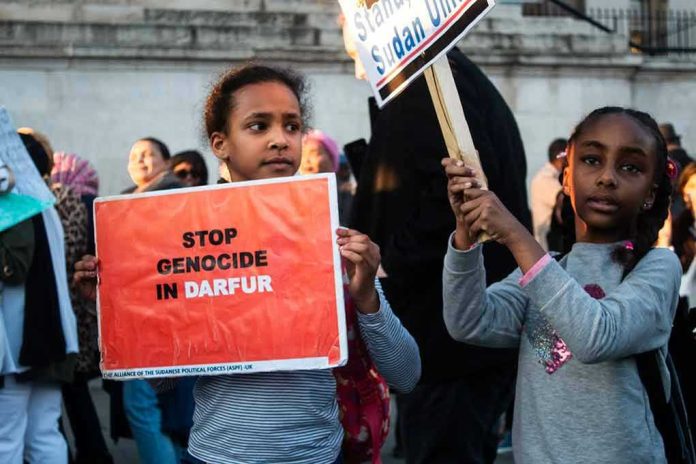
One hospital massacre in Darfur left hundreds dead, doctors abducted, and a continent’s conscience shaken—yet the world is still counting casualties in the dark, uncertain when the killing will end.
Story Highlights
- The Rapid Support Forces (RSF) seized Al-Fashir, Darfur’s last city under Sudanese army control, sparking a bloody hospital massacre.
- Hundreds of medical staff, patients, and civilians were killed at the Saudi maternity hospital—the final lifeline for 1.5 million trapped residents.
- Doctors labeled as “heroes” were abducted and held for ransom, deepening the humanitarian catastrophe.
- The massacre is part of a broader campaign of ethnic cleansing by RSF, with credible accusations of genocide and war crimes.
Fall of Al-Fashir: A City Under Siege and the Last Stand
The city of Al-Fashir, home to more than a million displaced Sudanese, became the final battleground in Darfur’s civil war when RSF launched its decisive assault in late October 2025. After months of siege, the Sudanese Armed Forces (SAF) retreated, leaving civilians stranded without food, water, or escape. The RSF’s capture of Al-Fashir marked not just a military victory, but an existential blow to humanitarian hopes in western Sudan. The last functioning hospital, a Saudi-funded maternity center, stood as the city’s only source of medical aid—until RSF fighters stormed its corridors.
Inside the hospital, the violence was swift and merciless. Reports from the World Health Organization and the Sudan Doctors Union confirm that hundreds of people—patients, doctors, and their companions—were gunned down in cold blood. The facility, which had weathered months without electricity or supplies, was transformed into a graveyard. Eyewitnesses describe the systematic targeting of medical staff, some hailed as “heroes” for remaining at their posts during the siege. Those not killed were abducted, their fate hanging on ransom demands as RSF tightened its grip on the city.
Origins of Violence: From Janjaweed to RSF and a Legacy of Genocide
The roots of Darfur’s agony stretch back decades. In the early 2000s, Janjaweed militias—now rebranded as RSF—waged a campaign of ethnic cleansing under the regime of Omar al-Bashir. After Bashir’s ouster in 2019, the RSF, led by Mohamed Hamdan Dagalo (“Hemeti”), grew into a dominant paramilitary force, now accused of continuing those genocidal policies. The current civil war erupted in 2023 between SAF and RSF, dragging the region into protracted violence. International organizations repeatedly warned that Darfur’s non-Arab communities faced systematic extermination, but diplomatic efforts failed to halt the bloodshed.
The massacre at the Saudi maternity hospital is the latest—and most horrifying—chapter in this narrative. Previous atrocities, such as the April 2025 attack on the ZamZam displacement camp, had already signaled RSF’s intent. The deliberate targeting of doctors and aid workers in Al-Fashir demonstrates a calculated strategy: destroy the last vestiges of humanitarian resistance, then erase the witnesses. The communications blackout imposed by RSF ensures that the true death toll may never be known, with satellite imagery providing the only window into the city’s devastation.
Aftermath and Escalation: Humanitarian Crisis and International Paralysis
RSF’s control of Al-Fashir has plunged Darfur into a humanitarian abyss. With all medical infrastructure destroyed, thousands of wounded and sick are left to die untreated. The abduction of medical staff compounds the crisis, depriving the region of its most vital resource. International agencies, including Médecins Sans Frontières and the UN, warn that up to 260,000 civilians remain trapped, many facing starvation or forced conscription. Appeals for humanitarian corridors have gone unanswered, as RSF consolidates power and SAF retreats.
The implications stretch far beyond Sudan. The collapse of healthcare and displacement of millions threatens to destabilize neighboring countries. Ethnic divisions deepen as survivors flee, carrying trauma and distrust. The Sudanese state itself faces fragmentation, with RSF now shaping the political and economic future of Darfur. International condemnation—led by Yale Humanitarian Research Lab and UN officials—has yet to translate into effective intervention, leaving survivors to wonder if justice will ever prevail.
Expert Analysis: Patterns of Atrocity and the Limits of International Response
Independent experts draw clear lines between the current massacre and historic patterns of genocide in Darfur. Yale Humanitarian Research Lab’s satellite evidence corroborates eyewitness accounts, indicating that the number of dead may far exceed initial estimates. Sudan Doctors Network classifies the incident as a “crime of ethnic cleansing,” while UN and U.S. officials openly accuse RSF of orchestrating genocide. The dominance of RSF, contrasted with the retreating SAF, has shifted power dynamics irreversibly in Darfur.
Yet, despite overwhelming documentation—from WHO, Médecins Sans Frontières, and Yale—the world’s response remains muted. The communications blackout, ongoing abductions, and unverified video evidence contribute to uncertainty. Multiple credible sources confirm the massacre and abductions, but contradictory figures and incomplete data obscure the full scale of the tragedy. As the humanitarian sector faces unprecedented risks, the absence of international action becomes a story in itself—one that may haunt policymakers and survivors for years to come.
Sources:
NPR/KGOU: ‘Trapped and terrified’: warnings as Sudanese militia seize Darfur city
VPM: Hundreds killed in Darfur hospital massacre, ‘hero’ doctors abducted






